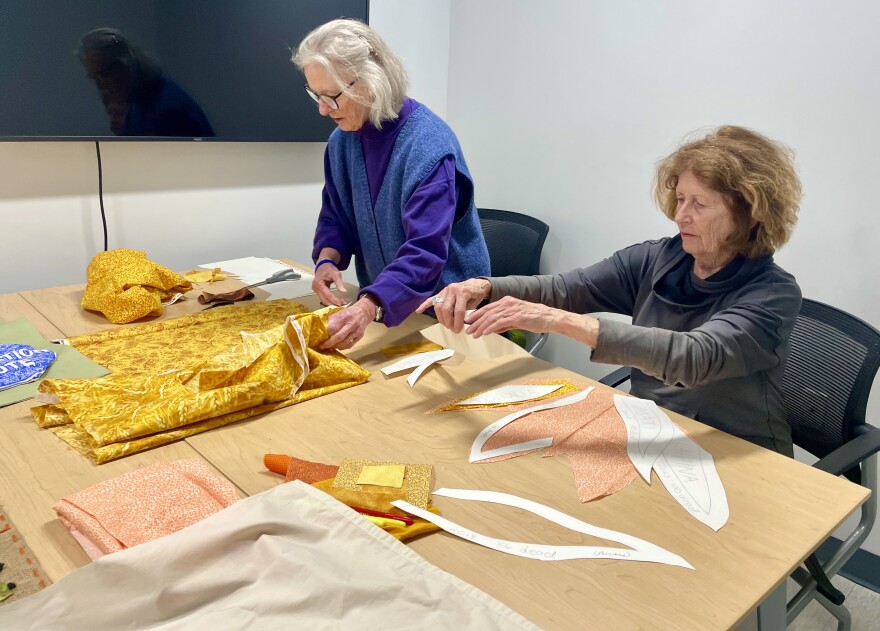On a recent Wednesday evening at Binghamton University, Lois Grady-Wesbecher carefully laid out pieces of brightly patterned yellow and orange fabric on a conference table, each one cut into the shape of a flame.
Working with her friend, Karen Jennings-Laskowski, she aimed to create a panel of a quilt that depicted recent wildfires — and their tolls.
“This one is Paradise, which was California in 2018, 86 people died,” said Grady-Wesbecher, pointing to one fabric flame. “This was Lahaina in Hawaii in 2023, 100 people died,” she added, pointing out another.
Soon, the women's quilt panel will be stitched together with others to create a quilted tapestry. It’s part of a project led by Binghamton University’s Office of Sustainability called the “Climate Change Quilt”. Hundreds of people have already contributed to it.
The aim, according to the university’s chief sustainability officer, Pamela Mischen, is to bring attention to the threats of climate change — and bring people together to talk about it, by quilting.
"I think most people around here perceive climate change as something that's still happening in the future, and not here, [but] someplace else," said Mischen. "But it's going to happen to everybody."

The dozens of quilts the group has made highlight different issues related to climate change, from extreme weather to ways to reduce greenhouse gas emissions that contribute to a warming world. University staff and students have contributed, as well as residents of a local retirement home and others who heard about the project.
Grady-Wesbecher and Jennings-Laskowski are both retired and learned about the project through a continuing education class they took with Mischen. Since then, they've been steadily contributing quilt panels. Some are personal, like a panel Grady-Wesbecher made that includes cutouts from t-shirts and other apparel she had kept from her time working for the Red Cross in disaster response.
Mischen said she got the idea for the quilt project after the last election. She worried that environmental issues hadn’t made it into the spotlight during the presidential campaign and debates, even though scientists have found that the risks of extreme weather and dangerous conditions are only becoming more severe.
“In thinking about this, I was like, OK, we need to be more visible and vocal,” said Mischen. “We need to give people something to talk about.”
Mischen was inspired by the AIDS quilt, an influential project that memorialized people who had died from AIDS that began in the 1980s. Mischen was in college then, and she said she remembers when activists first displayed its nearly 2,000 panels at the National Mall in Washington, D.C, bringing attention to an issue many at the time were afraid to talk about.
Her hope, she said, is that the climate change quilt will have a similar impact.

The project began this past winter, and Mischen’s office is now full of quilt segments made by more than 200 people. In total, the group has made 30 quilts so far. Some have intricate beadwork, colorful stitching, or words and symbols depicting key climate issues.
Katharine Stirber, a senior studying environmental science and geochemistry, contributed several panels. She said her favorite one depicts Hurricane Sandy, which she lived through as a child growing up on Long Island.
“I remember that being the first, like real, kind of scary event of climate change that I experienced,” said Stirber. “That kind of just stuck with me.”
Stirber’s quilt square has a green Statue of Liberty pinned to it, surrounded by waves made of cut-out blue fabric. She said making it gave her time to reflect on what she had experienced when she was younger.
“It was just kind of like a full-circle moment,” said Stirber. “I had a lot of fun putting it together, because it was just like a meaningful thing to me.”

The group plans to unveil the quilts at an event this weekend on Saturday, April 26 at the Fine Arts Grand Corridor at Binghamton University. The quilts will be on display from noon to 7 p.m.
Until then, Pamela Mischen said she’ll be busy sewing together the remaining quilt squares. Plus, she added, this is only the start. The group plans to host another event in the fall with the Tioga Arts Council.
Mischen said she hopes that down the line, there will be many more opportunities to display the quilts, with contributions from quilters across the country. Already, working with others on the quilts has been uplifting, she said.
“I'll come here, and I'll do this project, and all these people will show up, and it's like — that's where I get the energy,” said Mischen. “I've got to keep going. I can't be hopeless.”


